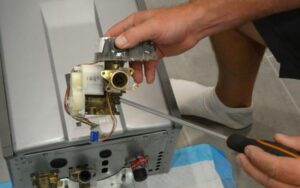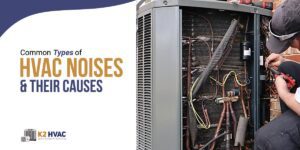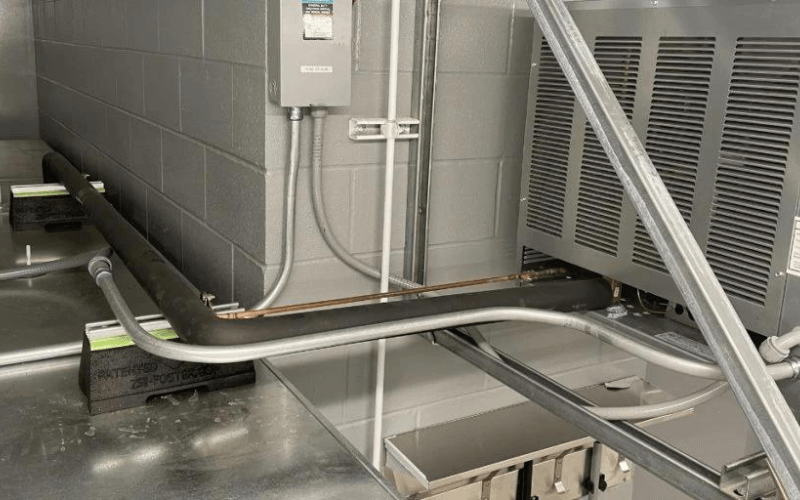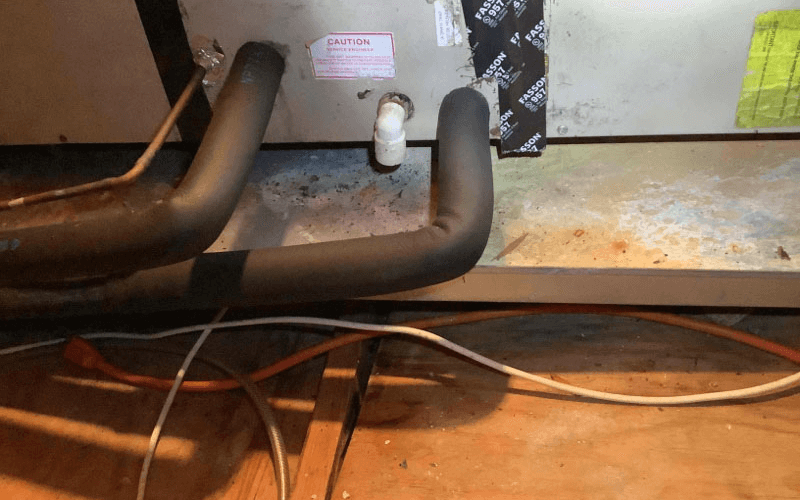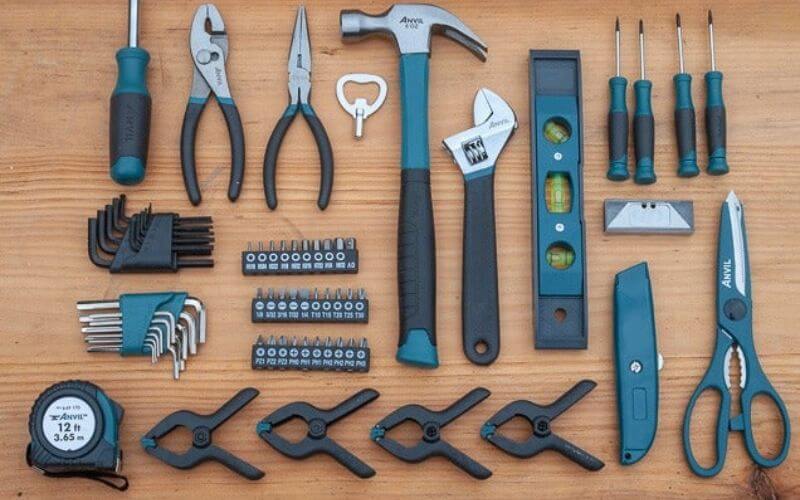Every modern homeowner should know how to vent a tankless heater properly. It not only demonstrates compliance with the local venting code, but it also emphasizes the importance of safety.
Table of Contents
ToggleTankless water heaters offer simpler venting systems than traditional storage water heaters. We will, however, go through two methods for securely venting the gases produced by a tankless water heater.
So, let’s get started.
How Should a Tankless Heating System Be Ventilated?
Decide How To Vent The Heater.
There are two types of exhaust and supply venting requirements for a tankless water heater. Remember that the power vent system’s blower must be linked to an electrical outlet. An exhaust system is utilized in tankless water heaters to remove combustion byproducts and hot air.
Installing a power or direct vent system is recommended by professionals. You can choose depending on your requirements.
Power venting ducts are suitable for wall venting since water heaters can be run horizontally from the heater.
Direct venting systems can function without electrical access due to the lack of such components. It can only work when placed vertically or diagonally. As a result, direct vents may be an excellent choice for roof ventilation.
Also, Read: How to Unfreeze Tankless Water Heater?
Examine The Ventilation Regulations In Your Area.
The PVC venting standards for tankless water heaters are specified in the National Fuel Gas Code ANSI Z223.1/NFPA.54. These recommendations, however, should be considered independently of national laws. As a result, you should validate the required venting distance between the tankless water heater and nearby objects with the local authorities.
Single-wall pipe requires 6 inches of vertical clearance, whereas connections to draught hoods require up to 12 inches. The water heater’s maker also includes an installation handbook with extra information.
Create A Ventilation System.
This step may be difficult if this is your first time installing a tankless water heater. Keep the following two points in mind:
- Please do not hook up tankless water heaters to existing ventilation systems.
- Experts also advise against connecting the tankless water heater to the same chimney vent as another appliance since this might cause safety hazards such as back-drafting.
To prepare the building for the installation of vent pipes by these two criteria, the following actions must be taken:
- To build a hole in a wall, you’ll need a hole saw and an electric drill (or a hammer and chisel). The opening must be large enough to accommodate the diameter of the exhaust hose.
- The sidewall aperture of a non-condensing unit should be 14 inches lower than the vent of a tankless water heater for every foot of vent pipe length.
- The opening in the side wall of a condensing tankless water heater must be larger than the vent (1/4 inch slope per foot). Drill two holes for direct venting systems: one for the exhaust and one for the combustion air (at least a foot apart).
Also, Read: How Much Propane Does A Tankless Water Heater Use.
Install The Ductwork And Ventilation Fans.
If you follow the manufacturer’s installation instructions, installing vent pipes for a tankless water heater in a garage, basement, or other location is simple. Connect the ventilation ducts to the system’s terminus. The following actions must be followed to vent the water heater.
- The water heater’s exhaust vent must be secured (the one that ends outside the home). To protect oneself from the elements, put on a draught hood, a weather collar, and a vent cap.
- Attach and fasten a vent duct to the tankless water heater’s top.
- To vent a tankless water heater through a side wall, use PVC to attach a 90-degree elbow to the top of the vertical vent.
- Connect a second right-angle elbow connector to the ducting’s outer end.
- Duct tape or foil tape should be used to seal the ends of the ventilation pipe. Caulk any gaps in the fan’s housing.
Also, Read: How to Vent Gas Water Heater In Basement?
Special Considerations for Tankless Water Heaters.
For inexperienced users, venting tankless water heaters might be complicated. Unsurprisingly, many homeowners would prefer to hire a professional installer rather than deal with all of the moving pieces themselves.
If you want to vent the system manually, consider the following variables.
Which is Better, Indoor or Outdoor Models?
Outdoor water heaters do not require venting because combustion byproducts evaporate rapidly into the atmosphere. Check the weather resilience of the goods to verify they can tolerate harsh circumstances.
Indoor models, on the other hand, will always require air circulation. In the lack of adequate ventilation, combustion byproducts may collect within the home, providing a health risk to the people.
Forced Ventilation vs. Direct Ventilation.
Direct systems require two openings: one for exhaust and one for combustion air. As a result, a motorized ventilation system may be the ideal alternative if you want to prevent exertion.
On the other hand, power venting necessitates a bigger space to evacuate combustion air from a building. On the other hand, direct systems require only 16 square feet of room to function correctly.
Choosing Between Condensing and Non-Condensing Heaters.
Condensing water heaters have lower exhaust gas temperatures and a 95 percent efficiency rating. As a result, polypropylene or PVC vent pipes can be utilized instead of metal vent pipes. These materials may result in cheaper overall installation costs.
Positioning of Concentrated Vents.
If you choose direct ventilation, you should consider sealing the system with a circular vent. This device keeps the vent cool and makes system maintenance easier.
Aesthetics.
Installing the tankless water heater in a wall recess box allows it to be “hidden.” These additions improve the unit’s attractiveness and may even lower its footprint. Beautiful terminals and vent pipe covers can improve a tankless water heater’s aesthetic appeal.
Also, Read: Rinnai Error Code 10.
Conclusion.
Learning how to vent a tankless water heater will be a breeze if you follow the installation instructions in the letter. Being aware of the various ventilation requirements and familiar with the available solutions may also be beneficial.
Our four-step procedure appears to be straightforward. However, we must emphasize the importance of carefully assessing whether a powered ventilation system or a direct ventilation arrangement should be used. A competent professional can if you don’t have the time or energy to deal with your problems alone
FAQ
Do tankless heaters need to be vented?
No. Unlike gas tankless water heaters and gas traditional tank style water heaters, electric tankless water heaters do not require any venting. This is often one of the deciding factors when choosing whether you should purchase a gas or electric tankless water heater.
What are the rules for venting a hot water heater?
The horizontal run of vent pipe shall not exceed three-fourths of the vertical rise of the flue to which the vent is attached. The vent pipe shall be pitched upward from the water heater with a slope of not less than one-fourth inch vertically for each foot of horizontal run.
What material is used for tankless water heater venting?
Noncondensing tankless water heaters typically transfer to the water only about 80% of the heat they generate. The remaining heat creates a hot exhaust gas that requires metal venting, typically stainless steel or thick aluminum.



